Recycling of Macro-Synthetic Fiber-Reinforced Concrete and Properties of New Concretes with Recycled Aggregate and Recovered Fibers
Abstract
:1. Introduction
1.1. Background
1.2. Objective and Significance of the Research
2. Materials and Methods
2.1. Concept of the Study
2.2. Materials
2.3. Mix Design
2.4. Methods
- is the residual flexural tensile, MPa;
- Fj is the load corresponding to CMOD = CMODj, N;
- is the span length, mm;
- is the width of the specimen, mm;
- hsp is the distance between the tip of the notch and the top of the specimen, mm.
3. Results and Discussion
3.1. Distribution of RA and Fiber Recovery
3.2. Basic Concrete Properties
3.3. Axial Stress–Strain Behavior
3.4. The Residual Flexural Tensile Strength
4. Conclusions
- In terms of PPFRC recycling, the fiber content in the concrete being crushed does not affect the particle size distribution of the RA and the shape of the RF, only the fiber recovery rate. The percentage of recovered fiber increases with the fiber content of the original concrete.
- Concretes with 100% coarse RA can achieve the same compressive strength as the parent concrete, but with a lower modulus of elasticity by increasing the cement content and lowering the water–cement ratio. When the mixture design is the same, concrete with 100% recycled fiber has little effect on the compressive strength and modulus of elasticity when the fiber content is low compared to concrete with virgin fiber, while both properties are slightly reduced when the fiber content is high.
- The residual flexural tensile strength of concrete is decreased by approximately 50% when 100% of virgin fibers are replaced by RF. This is explained by the smaller average length of RF. However, concrete with 100% coarse RA has improved the residual flexural tensile strength compared to natural aggregate due to the recycled aggregate embedded fiber. The residual (flexural and compression) strength of concrete can increase when RA obtained from PPFRC recycling is used, due to the contribution of the fibers that remain embedded in the RA. This means that the RA obtained from PPFRC recycling can bring a higher added value to new concrete and should, therefore, be treated and stockpiled differently in CDW plants. Both RA and RF as recycled materials can be used in structural applications, such as buildings, by adjusting the mixture design. However, there are still knowledge gaps, such as the porosity of the RA and the influence of the distribution of the RF on the interfacial transition zone (ITZ) of the concrete, which are still worth investigating.
Author Contributions
Funding
Data Availability Statement
Conflicts of Interest
References
- Medina, C.; Zhu, W.; Howind, T.; Sánchez de Rojas, M.I.; Frías, M. Influence of Mixed Recycled Aggregate on the Physical—Mechanical Properties of Recycled Concrete. J. Clean. Prod. 2014, 68, 216–225. [Google Scholar] [CrossRef]
- Verian, K.P.; Ashraf, W.; Cao, Y. Properties of Recycled Concrete Aggregate and Their Influence in New Concrete Production. Resour. Conserv. Recycl. 2018, 133, 30–49. [Google Scholar] [CrossRef]
- Scrivener, K.L.; John, V.M.; Gartner, E.M. Eco-Efficient Cements: Potential Economically Viable Solutions for a Low-CO2 Cement-Based Materials Industry. Cem. Concr. Res. 2018, 114, 2–26. [Google Scholar] [CrossRef]
- Nedeljković, M.; Visser, J.; Šavija, B.; Valcke, S.; Schlangen, E. Use of Fine Recycled Concrete Aggregates in Concrete: A Critical Review. J. Build. Eng. 2021, 38, 102196. [Google Scholar] [CrossRef]
- Chen, W.; Jin, R.; Xu, Y.; Wanatowski, D.; Li, B.; Yan, L.; Pan, Z.; Yang, Y. Adopting Recycled Aggregates as Sustainable Construction Materials: A Review of the Scientific Literature. Constr. Build. Mater. 2019, 218, 483–496. [Google Scholar] [CrossRef]
- de Larrard, F.; Colina, H. Concrete Recycling: Research and Practice; CRC Press: Boca Raton, FL, USA, 2019; ISBN 1-351-05281-0. [Google Scholar]
- de Brito, J.; Agrela, F.; Silva, R.V. 1—Construction and Demolition Waste. In New Trends in Eco-Efficient and Recycled Concrete; de Brito, J., Agrela, F., Eds.; Woodhead Publishing Series in Civil and Structural Engineering; Woodhead Publishing: Sawston, UK, 2019; pp. 1–22. ISBN 978-0-08-102480-5. [Google Scholar]
- Santos, S.; da Silva, P.R.; de Brito, J. Self-Compacting Concrete with Recycled Aggregates—A Literature Review. J. Build. Eng. 2019, 22, 349–371. [Google Scholar] [CrossRef]
- Akhtar, A.; Sarmah, A.K. Construction and Demolition Waste Generation and Properties of Recycled Aggregate Concrete: A Global Perspective. J. Clean. Prod. 2018, 186, 262–281. [Google Scholar] [CrossRef]
- Xie, J.; Kou, S.; Ma, H.; Long, W.-J.; Wang, Y.; Ye, T.-H. Advances on Properties of Fiber Reinforced Recycled Aggregate Concrete: Experiments and Models. Constr. Build. Mater. 2021, 277, 122345. [Google Scholar] [CrossRef]
- Carlesso, D.M.; Cavalaro, S.; de la Fuente, A. Flexural Fatigue of Pre-Cracked Plastic Fiber Reinforced Concrete: Experimental Study and Numerical Modeling. Cem. Concr. Compos. 2021, 115, 103850. [Google Scholar] [CrossRef]
- Zeybek, Ö.; Özkılıç, Y.O.; Çelik, A.İ.; Deifalla, A.F.; Ahmad, M.; Sabri Sabri, M.M. Performance Evaluation of Fiber-Reinforced Concrete Produced with Steel Fibers Extracted from Waste Tire. Front. Mater. 2022, 9, 1057128. [Google Scholar] [CrossRef]
- Serrano, R.; Cobo, A.; Prieto, M.I.; González, M.D.L.N. Analysis of Fire Resistance of Concrete with Polypropylene or Steel Fibers. Constr. Build. Mater. 2016, 122, 302–309. [Google Scholar] [CrossRef]
- Zhang, D.; Yu, J.; Wu, H.; Jaworska, B.; Ellis, B.R.; Li, V.C. Discontinuous Micro-Fibers as Intrinsic Reinforcement for Ductile Engineered Cementitious Composites (ECC). Compos. Part B Eng. 2020, 184, 107741. [Google Scholar] [CrossRef]
- Das, C.S.; Dey, T.; Dandapat, R.; Mukharjee, B.B.; Kumar, J. Performance Evaluation of Polypropylene Fiber Reinforced Recycled Aggregate Concrete. Constr. Build. Mater. 2018, 189, 649–659. [Google Scholar] [CrossRef]
- Ahmed, T.W.; Ali, A.A.M.; Zidan, R.S. Properties of High Strength Polypropylene Fiber Concrete Containing Recycled Aggregate. Constr. Build. Mater. 2020, 241, 118010. [Google Scholar] [CrossRef]
- Eguchi, K.; Teranishi, K.; Nakagome, A.; Kishimoto, H.; Shinozaki, K.; Narikawa, M. Application of Recycled Coarse Aggregate by Mixture to Concrete Construction. Constr. Build. Mater. 2007, 21, 1542–1551. [Google Scholar] [CrossRef]
- Xiao, J.; Li, W.; Fan, Y.; Huang, X. An Overview of Study on Recycled Aggregate Concrete in China (1996–2011). Constr. Build. Mater. 2012, 31, 364–383. [Google Scholar] [CrossRef]
- Durmuş, G.; Şimşek, O.; Dayi, M. The Effects of Coarse Recycled Concrete Aggregates on Concrete Properties. J. Fac. Eng. Archit. Gazi Univ. 2009, 24, 183–189. [Google Scholar]
- Prieto, M.I.; González, M.d.l.N.; Cobo, A.; Alonso, D. Comparison of the Mechanical Behavior of Concrete Containing Recycled CFRP Fibers and Polypropylene Fibers. Appl. Sci. 2021, 11, 10226. [Google Scholar] [CrossRef]
- Carneiro, J.A.; Lima, P.R.L.; Leite, M.B.; Toledo Filho, R.D. Compressive Stress–Strain Behavior of Steel Fiber Reinforced-Recycled Aggregate Concrete. Cem. Concr. Compos. 2014, 46, 65–72. [Google Scholar] [CrossRef]
- Salesa, Á.; Pérez-Benedicto, J.Á.; Esteban, L.M.; Vicente-Vas, R.; Orna-Carmona, M. Physico-Mechanical Properties of Multi-Recycled Self-Compacting Concrete Prepared with Precast Concrete Rejects. Constr. Build. Mater. 2017, 153, 364–373. [Google Scholar] [CrossRef]
- Kunieda, M.; Ueda, N.; Nakamura, H. Ability of Recycling on Fiber Reinforced Concrete. Constr. Build. Mater. 2014, 67, 315–320. [Google Scholar] [CrossRef]
- Tošić, N.; Peralta Martínez, D.; Hafez, H.; Reynvart, I.; Ahmad, M.; Liu, G.; de la Fuente, A. Multi-Recycling of Polypropylene Fiber Reinforced Concrete: Influence of Recycled Aggregate Properties on New Concrete. Constr. Build. Mater. 2022, 346, 128458. [Google Scholar] [CrossRef]
- Tam, V.W.Y.; Gao, X.F.; Tam, C.M. Microstructural Analysis of Recycled Aggregate Concrete Produced from Two-Stage Mixing Approach. Cem. Concr. Res. 2005, 35, 1195–1203. [Google Scholar] [CrossRef]
- Pradhan, S.; Kumar, S.; Barai, S.V. Recycled Aggregate Concrete: Particle Packing Method (PPM) of Mix Design Approach. Constr. Build. Mater. 2017, 152, 269–284. [Google Scholar] [CrossRef]
- Lin, Y.-H.; Tyan, Y.-Y.; Chang, T.-P.; Chang, C.-Y. An Assessment of Optimal Mixture for Concrete Made with Recycled Concrete Aggregates. Cem. Concr. Res. 2004, 34, 1373–1380. [Google Scholar] [CrossRef]
- EN 14651:2005; CEN Test Method for Metallic Fibered Concrete—Measuring the Flexural Tensile Strength (Limit of Proportionality (LOP), Residual). European Standard EN: Pilsen, Czech Republic, 2005; Volume 14651, p. 17.
- EN 1097-6:2013; CEN Tests for Mechanical and Physical Properties of Aggregates, Part 6: Determination of Particle Density and Water Absorption. European Standard EN: Pilsen, Czech Republic, 2014; Volume 1097, p. 52.
- Silva, R.V.; de Brito, J.; Dhir, R.K. Establishing a Relationship between Modulus of Elasticity and Compressive Strength of Recycled Aggregate Concrete. J. Clean. Prod. 2016, 112, 2171–2186. [Google Scholar] [CrossRef]
- Xiao, J.; Li, J.; Zhang, C. Mechanical Properties of Recycled Aggregate Concrete under Uniaxial Loading. Cem. Concr. Res. 2005, 35, 1187–1194. [Google Scholar] [CrossRef]
- Silva, R.V.; de Brito, J.; Dhir, R.K. Tensile Strength Behaviour of Recycled Aggregate Concrete. Constr. Build. Mater. 2015, 83, 108–118. [Google Scholar] [CrossRef]

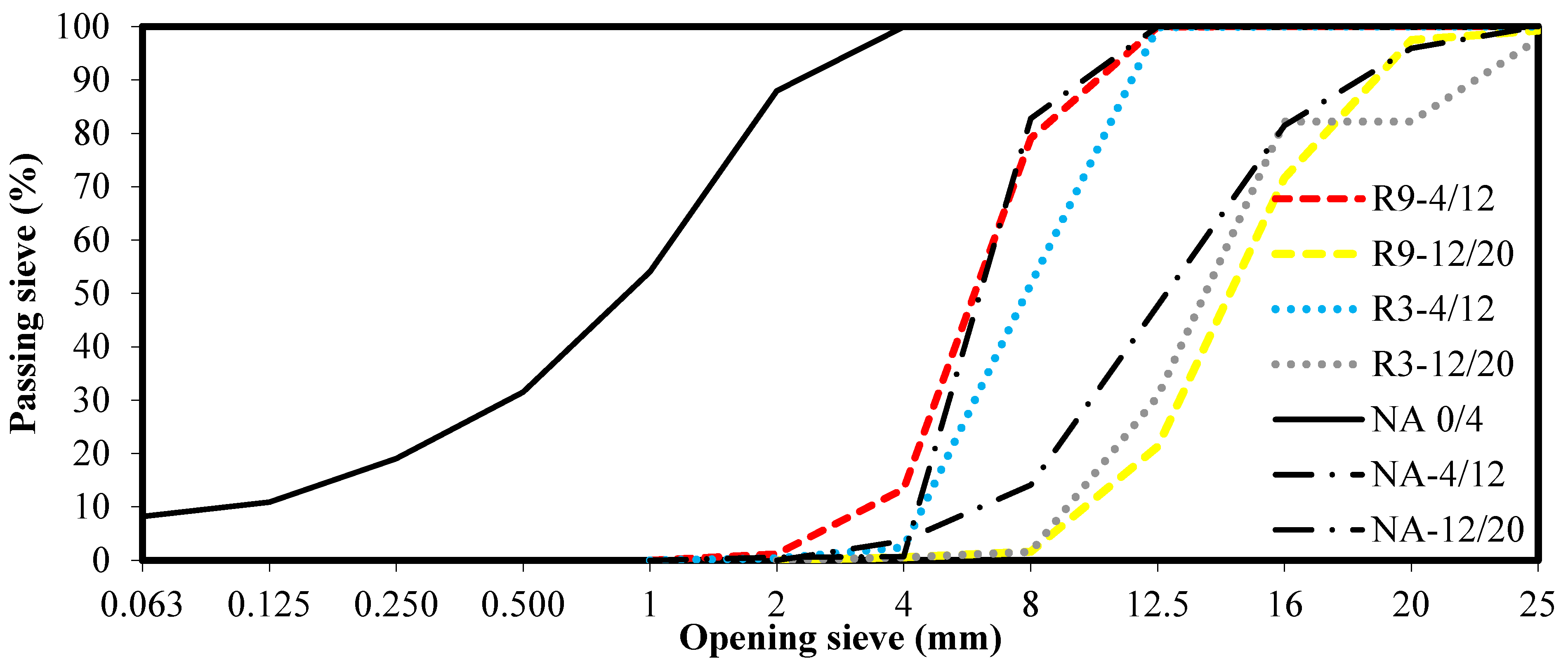
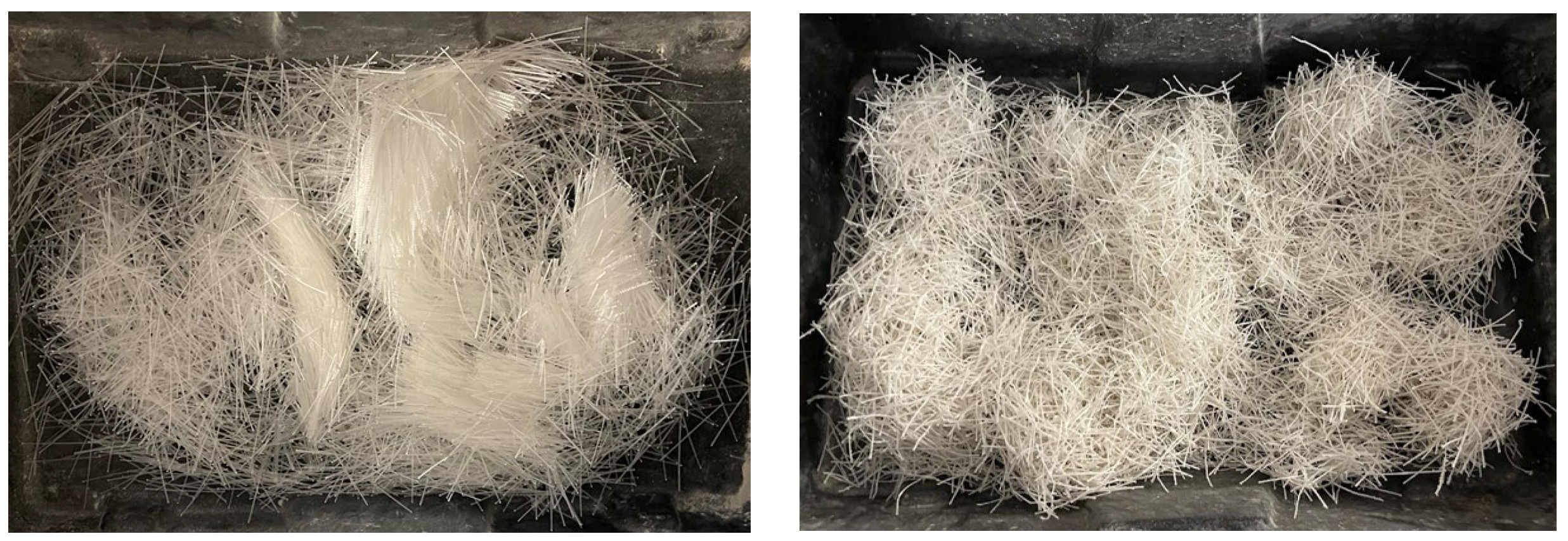
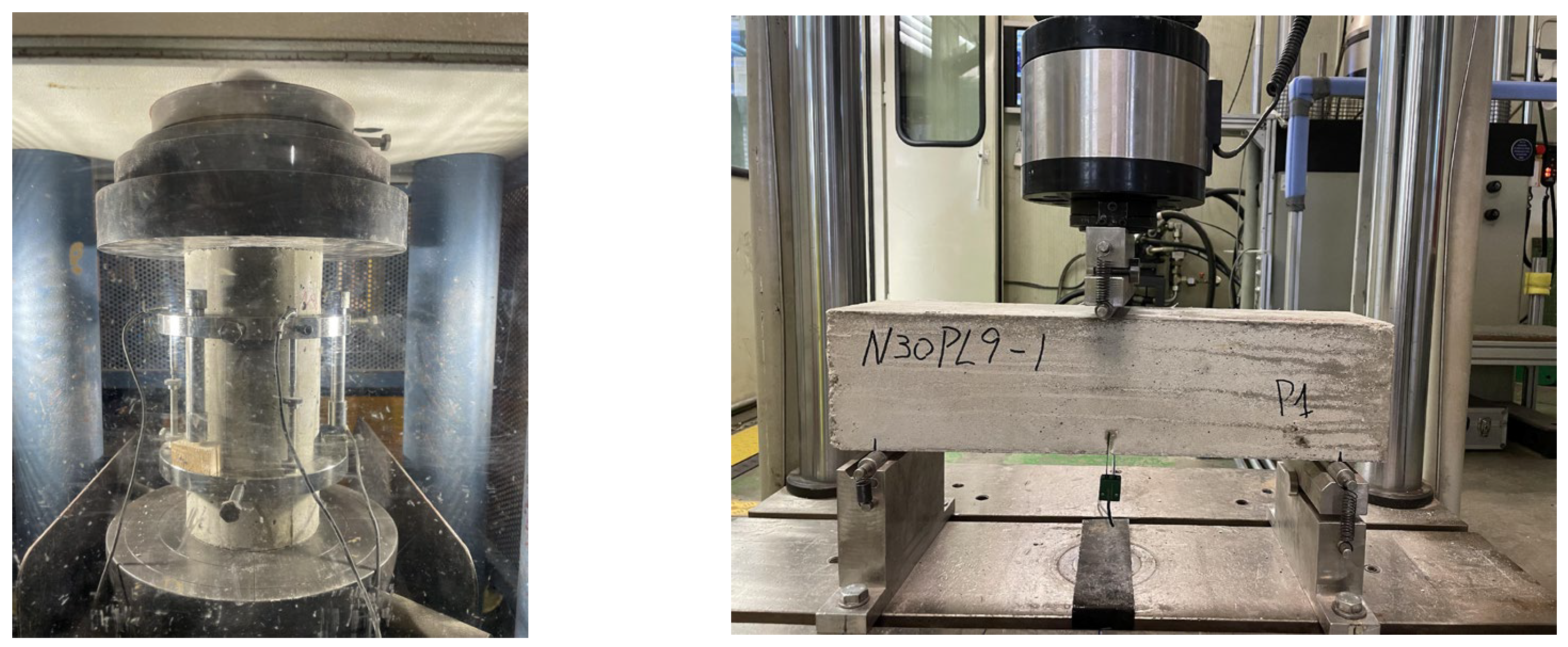
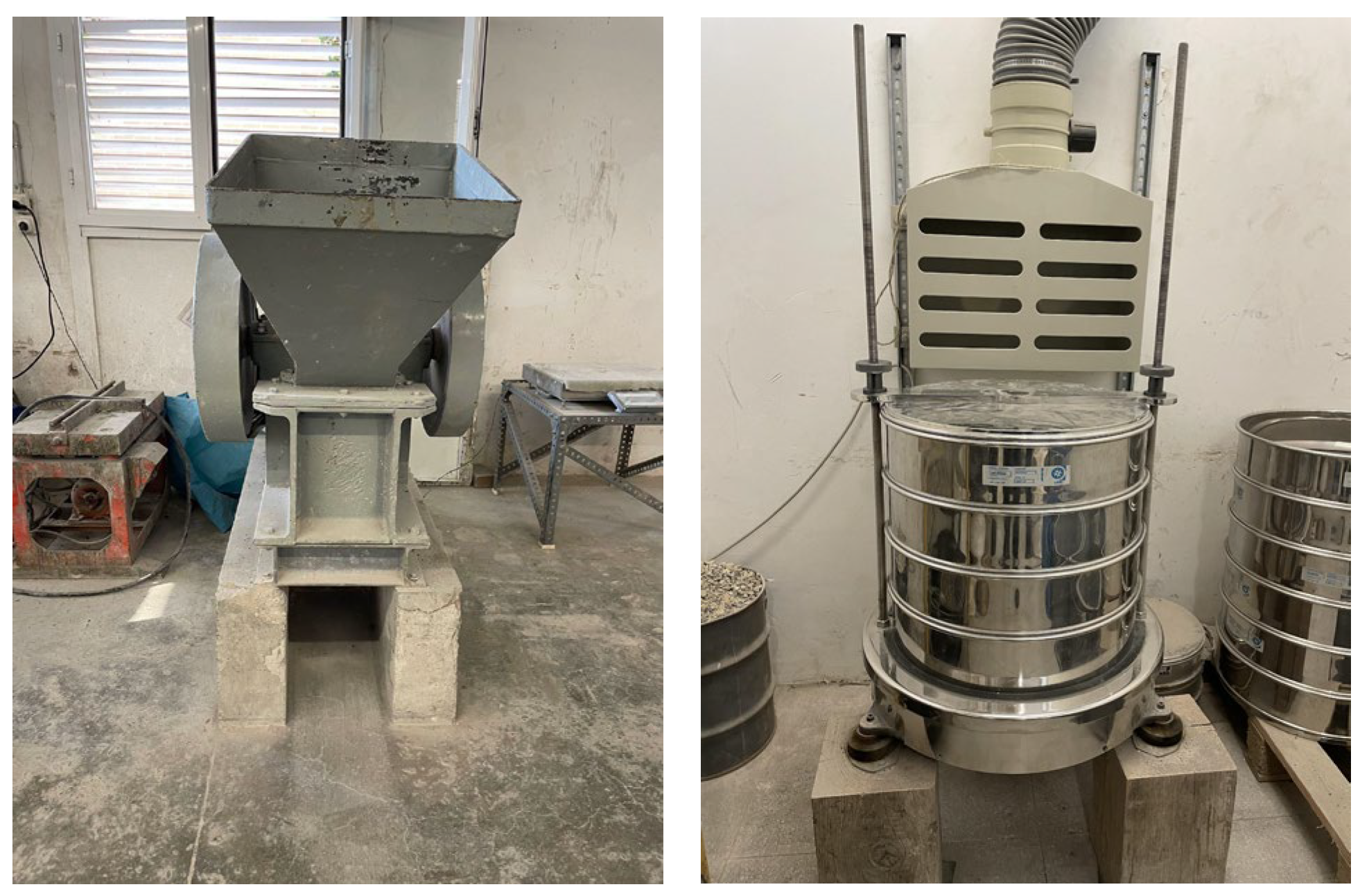

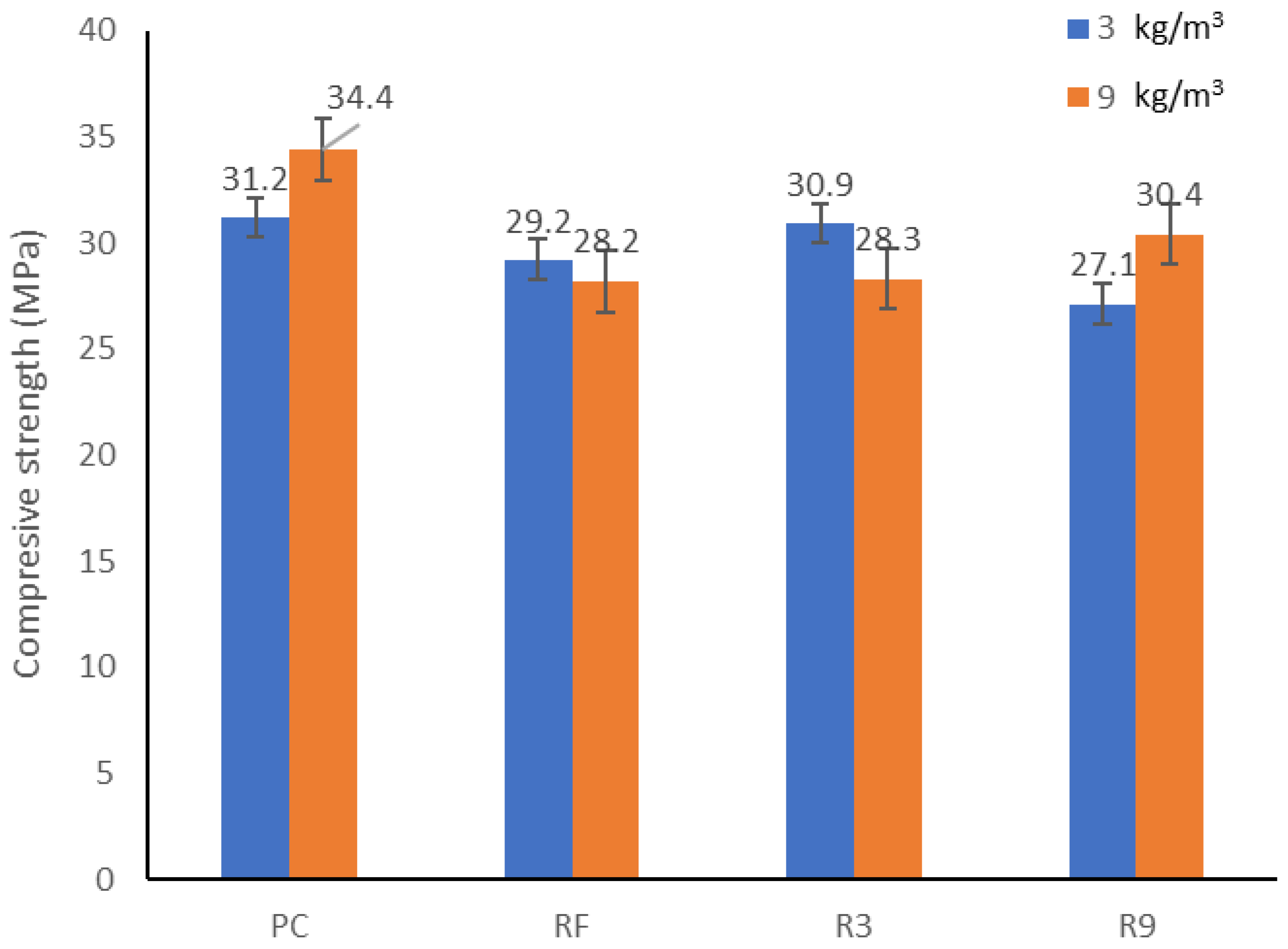
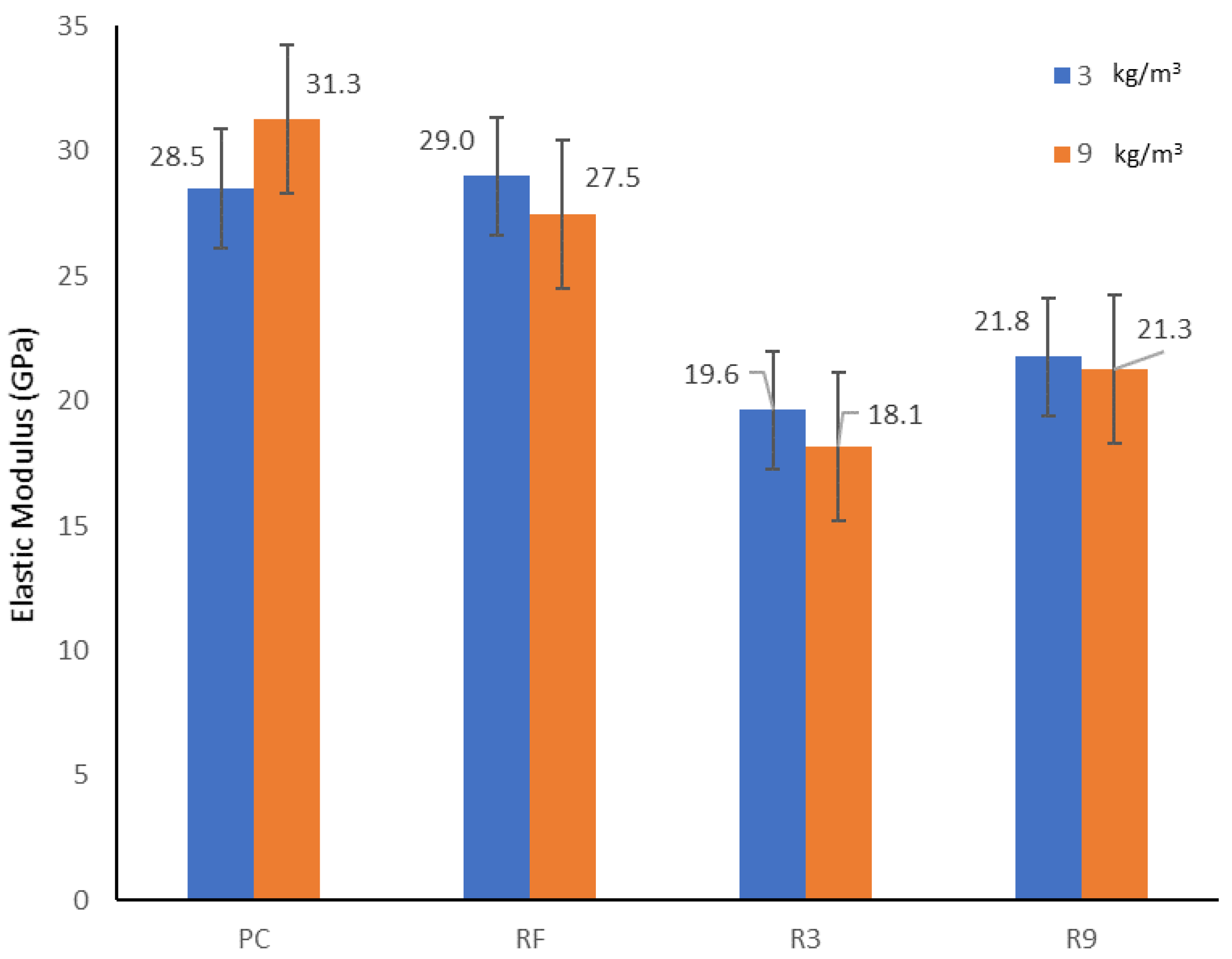

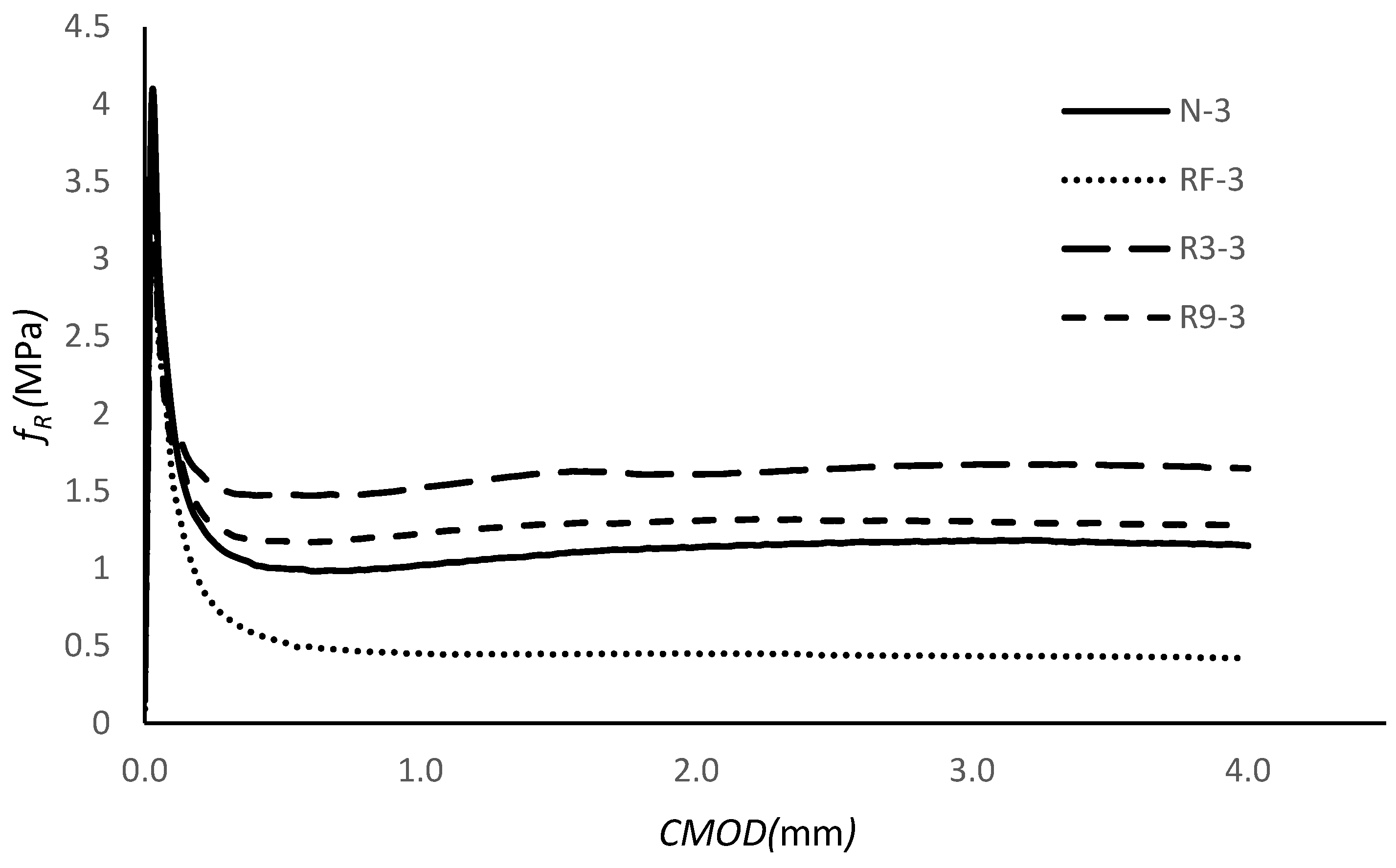
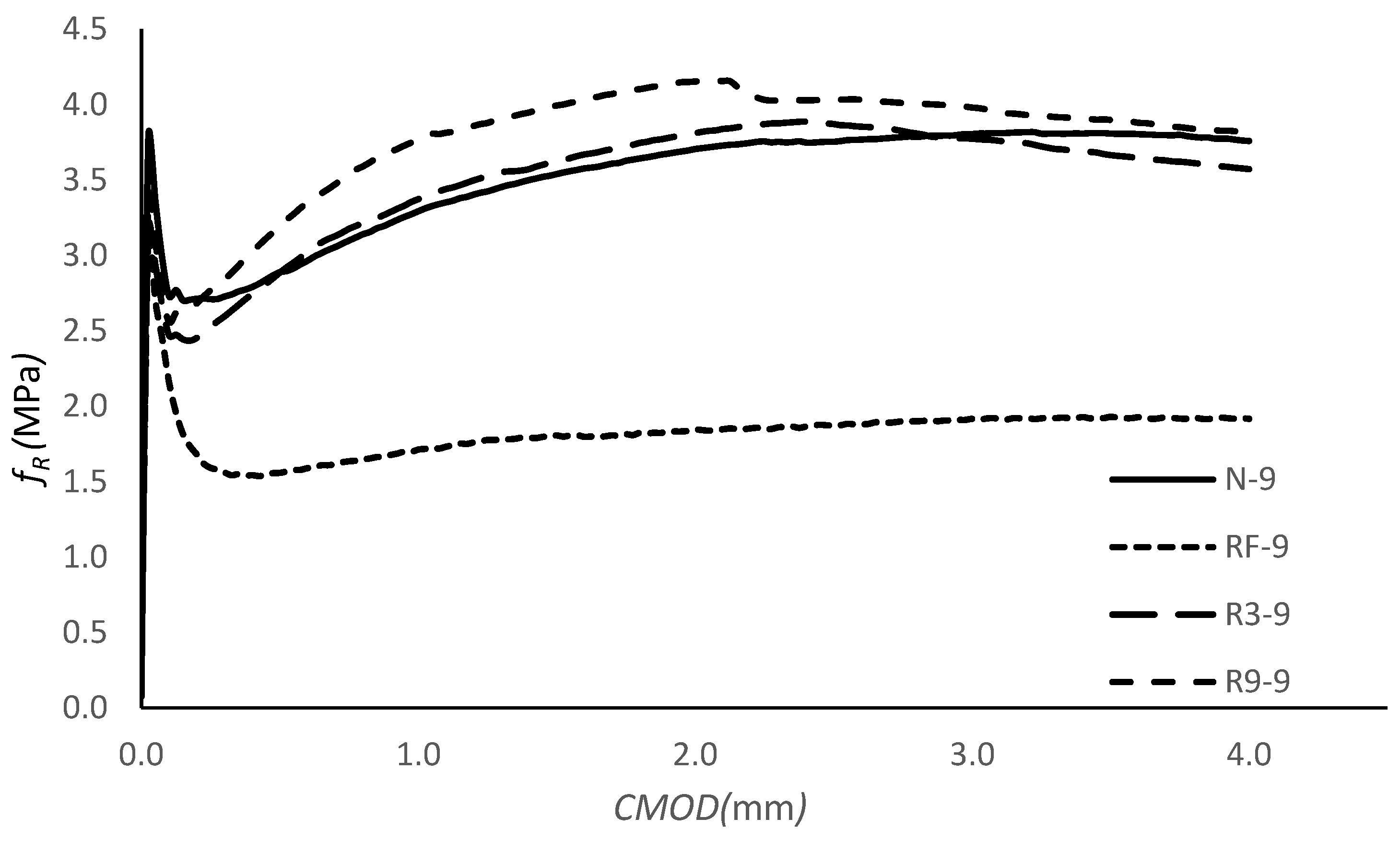

| Type | Fraction | Fines Content (%) | 24 h Water Absorption (%) | Oven-Dry Density (kg/m3) |
|---|---|---|---|---|
| Natural Aggregate | 0/4 mm | 8.1 | 1.56 | 2590 |
| 4/12 mm | 0.5 | 0.57 | 2690 | |
| 12/20 mm | 2.4 | 0.61 | 2680 | |
| Recycled Aggregate (R3) | 4/12 mm | 6.1 | 6.64 | 2270 |
| 12/20 mm | 2.6 | 3.63 | 2440 | |
| Recycled Aggregate (R9) | 4/12 mm | 5.2 | 7.04 | 2250 |
| 12/20 mm | 4.9 | 6.68 | 2260 |
| Concrete | Cement (kg/m3) | weff1 (kg/m3) | wadd2 (kg/m3) | Plast. (%cem.) | NA (kg/m3) | RCA (kg/m3) | Fiber (kg/m3) | ||||
|---|---|---|---|---|---|---|---|---|---|---|---|
| 0/4 mm | 4/12 mm | 12/20 mm | 4/12 mm | 12/20 mm | Virgin | Recovered | |||||
| N-3 | 350 | 192.5 | 0.00 | 0.80 | 782.6 | 265.9 | 706.4 | 0.0 | 3.00 | ||
| N-9 | 2.73 | 770.5 | 261.8 | 695.5 | 9.00 | ||||||
| RF-3 | 0.80 | 782.6 | 265.9 | 706.4 | 3.00 | ||||||
| RF-9 | 2.73 | 770.5 | 261.8 | 695.5 | 9.00 | ||||||
| R3-3 | 385 | 36.48 | 1.26 | 638.6 | 0.0 | 478.9 | 478.9 | 3.00 | |||
| R3-9 | 2.53 | 632.1 | 474.1 | 474.1 | 9.00 | ||||||
| R9-3 | 29.27 | 1.49 | 638.6 | 478.9 | 478.9 | 3.00 | |||||
| R9-9 | 3.00 | 632.1 | 474.1 | 474.1 | 9.00 | ||||||
| Parent Concrete | RA Distribution (%) | RF Distribution (%) | Fiber Recovery Ratio (%) | ||||
|---|---|---|---|---|---|---|---|
| 4/12 mm | 12/20 mm | Others | Long | Short | Bent | ||
| N-3 | 33.9 | 23.3 | 42.8 | 37.9 | 19.0 | 43.1 | 39.8 |
| N-9 | 34.1 | 28.1 | 37.8 | 32.9 | 29.6 | 37.5 | 53.1 |
| Concrete | Slump (mm) | fc (MPa) | Ec (MPa) |
|---|---|---|---|
| N-3 | 134 | 31.2 (1.8%) | 28,449 (2.4%) |
| N-9 | 107 | 34.4 (0.3%) | 31,253 (5.7%) |
| RF-3 | 135 | 29.2 (1.2%) | 28,983 (5.0%) |
| RF-9 | 115 | 28.2 (11.7%) | 27,479 (2.1%) |
| R3-3 | 143 | 30.9 (4.8%) | 19,627 (11.5%) |
| R3-9 | 120 | 28.3 (0.7%) | 18,147 (5.0%) |
| R9-3 | 102 | 27.1 (2.7%) | 21,772 (8.4%) |
| R9-9 | 114 | 30.4 (5.5%) | 21,270 (12.6%) |
| Concrete | fLOP | fR1 | fR2 | fR3 | fR4 |
|---|---|---|---|---|---|
| N-3 | 4.00 (5.1%) | 0.97 (19.0%) | 1.06 (24.3%) | 1.12 (24.4%) | 1.13 (24.1%) |
| N-9 | 3.78 (1.6%) | 2.89 (13.7%) | 3.54 (16.2%) | 3.75 (15.0%) | 3.80 (14.0%) |
| RF-3 | 3.54 (4.9%) | 0.53 (34.2%) | 0.45 (44.5%) | 0.44 (40.0%) | 0.43 (35.1%) |
| RF-9 | 3.15 (3.6%) | 1.56 (20.5%) | 1.81 (23.8%) | 1.87 (23.0%) | 1.93 (24.4%) |
| R3-3 | 3.34 (14.0%) | 1.48 (53.3%) | 1.62 (53.1%) | 1.64 (47.3%) | 1.09 (70.4%) |
| R3-9 | 3.23 (2.2%) | 2.89 (11.3%) | 3.62 (10.3%) | 3.87 (10.6%) | 3.79 (10.8%) |
| R9-3 | 3.36 (–) | 1.18 (–) | 1.29 (–) | 1.31 (–) | 1.28 (–) |
| R9-9 | 3.43 (–) | 3.20 (–) | 3.99 (–) | 4.03 (–) | 3.90 (–) |
Disclaimer/Publisher’s Note: The statements, opinions and data contained in all publications are solely those of the individual author(s) and contributor(s) and not of MDPI and/or the editor(s). MDPI and/or the editor(s) disclaim responsibility for any injury to people or property resulting from any ideas, methods, instructions or products referred to in the content. |
© 2023 by the authors. Licensee MDPI, Basel, Switzerland. This article is an open access article distributed under the terms and conditions of the Creative Commons Attribution (CC BY) license (https://creativecommons.org/licenses/by/4.0/).
Share and Cite
Liu, G.; Tošić, N.; de la Fuente, A. Recycling of Macro-Synthetic Fiber-Reinforced Concrete and Properties of New Concretes with Recycled Aggregate and Recovered Fibers. Appl. Sci. 2023, 13, 2029. https://doi.org/10.3390/app13042029
Liu G, Tošić N, de la Fuente A. Recycling of Macro-Synthetic Fiber-Reinforced Concrete and Properties of New Concretes with Recycled Aggregate and Recovered Fibers. Applied Sciences. 2023; 13(4):2029. https://doi.org/10.3390/app13042029
Chicago/Turabian StyleLiu, Guanzhi, Nikola Tošić, and Albert de la Fuente. 2023. "Recycling of Macro-Synthetic Fiber-Reinforced Concrete and Properties of New Concretes with Recycled Aggregate and Recovered Fibers" Applied Sciences 13, no. 4: 2029. https://doi.org/10.3390/app13042029
APA StyleLiu, G., Tošić, N., & de la Fuente, A. (2023). Recycling of Macro-Synthetic Fiber-Reinforced Concrete and Properties of New Concretes with Recycled Aggregate and Recovered Fibers. Applied Sciences, 13(4), 2029. https://doi.org/10.3390/app13042029






